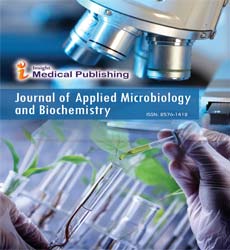ISSN : ISSN: 2576-1412
Journal of Applied Microbiology and Biochemistry
One Health Approach to Tackling Cross-Species Transmission in a Globalized World
Emma Carter*
Department of Microbiology, Ball State University, Muncie, USA
- *Corresponding Author:
- Emma Carterd
Department of Microbiology, Ball State University, Muncie,
USA,
Email: CarterEmma11@gmail.com
Received date: September 26, 2024, Manuscript No. IPJAMB-24-19870; Editor assigned date: September 30, 2024, PreQC No. IPJAMB-24-19870 (PQ); Reviewed date: October 14, 2024, QC No. IPJAMB-24-19870; Revised date: October 21, 2024, Manuscript No. IPJAMB-24-19870 (R); Published date: October 28, 2024, DOI: 10.36648/2576-1412.8.5.248
Citation: Carter E (2024) One Health Approach to Tackling Cross-Species Transmission in a Globalized World. J Appl Microbiol Biochem Vol. 8 No.5:248.
Description
In our interconnected world, the health of humans, animals, and ecosystems is intrinsically linked. The one health concept emphasizes this interconnection, addressing the need for a multidisciplinary approach to tackle shared health challenges. At the forefront of these challenges is cross-species transmission, where microbial pathogens jump from one species to another, sometimes with devastating consequences. Recognizing the shared vulnerabilities between humans, animals and the environment is important to preventing and managing outbreaks. This article describes the how cross-species transmission occurs, the factors that drive it and how a one health approach can help mitigate these risks.
Environmental drivers of cross-species transmission
Cross-species transmission, often called “spill over,” happens when a pathogen jumps from one host species to another, sometimes with a high potential for harm in the new host. Zoonotic diseases-those originating in animals and transferred to humans-make up approximately 60% of all known infectious diseases. Notable examples include viruses like Severe Acute Respiratory Syndrome (SARS), Middle East Respiratory Syndrome (MERS), Ebola and the recent SARS-CoV-2, which began in animals and through transmission dynamics, gained the ability to infect humans. While zoonotic viruses often receive the most attention, bacteria, fungi and other microbes can also undergo cross-species transmission, sometimes contributing to significant public health challenges. Microbial pathogens have unique abilities that enable them to cross species barriers. For instance, viral pathogens are known for their high mutation rates, which enable them to rapidly adapt to new host environments. Genetic mutations in key viral proteins allow them to latch onto receptors in the cells of a new host, facilitating the invasion process. Bacteria, on the other hand, can acquire genes from different sources through horizontal gene transfer, gaining new abilities that allow them to survive in diverse hosts. This adaptability enables pathogens to move across host species, particularly when given opportunities for repeated contact. Environmental factors also significantly contribute to spillover events, many of which are human-induced. Habitat destruction, deforestation, urbanization and climate change are all environmental disruptions that can increase human and animal interactions, providing new opportunities for cross-species transmission. For instance, when natural habitats are destroyed for urban expansion, animals are often forced into closer contact with human populations. This dynamic has been observed in regions where rapid deforestation occurs, as people come into closer proximity to wildlife reservoirs harboring unknown pathogens. Similarly, intensive agriculture and factory farming have been shown to facilitate the transmission of pathogens among animals, which can lead to potential spillover events in humans. High-density farming environments, where animals are kept in close quarters, create ideal conditions for microbial pathogens to circulate, evolve and adapt to new hosts. Climate change is also altering the landscapes of pathogen transmission. Warmer temperatures and shifting weather patterns allow certain vectors, like mosquitoes, to thrive in new regions, expanding the reach of diseases such as malaria, dengue and Zika virus. Rising temperatures in the ocean have led to changes in marine ecosystems, affecting the distribution of pathogens that can impact both wildlife and human health. With species migrating to adapt to climate change, pathogens are carried into new areas, potentially bringing diseases to previously unaffected populations. These environmental shifts increase the complexity of cross-species transmission, making it important to address ecological impacts within a one health framework.
Solutions for cross-species infection
The one health approach is a comprehensive strategy for preventing and responding to cross-species transmission. It involves collaboration across disciplines, including public health, microbiology, veterinary science, environmental science and policy, to address shared health threats. Surveillance is a core component, focusing on early detection and monitoring of pathogens in wildlife, livestock and human populations. By tracking pathogen mutations and adaptations, scientists can identify early warning signs of spillover risk and implement preemptive measures to prevent large-scale outbreaks. One health strategies include controlling zoonotic diseases in their animal reservoirs, such as vaccination programs in livestock and wildlife and improving sanitation and hygiene practices in animal farming practices. Implementing rigorous sanitation protocols, proper waste management and limiting antibiotic use in livestock can reduce the risk of emerging antibiotic-resistant bacterial strains, protecting both animal and human health.
Educating communities most vulnerable to zoonotic diseases is another critical component of One Health. Awareness campaigns targeting these populations can help mitigate risky practices and promote behaviour changes that reduce direct contact with potential reservoirs of disease. Policymakers and healthcare officials play a vitalrole in enacting and enforcing regulations that that limit human-animal interactions in high-risk areas. The one health approach emphasizes the need for strong international collaboration, as infectious diseases do not recognize borders. Rapid detection and response mechanisms can be coordinated globally, especially in low-resource regions where zoonotic diseases often emerge and health infrastructure may be limited.
Open Access Journals
- Aquaculture & Veterinary Science
- Chemistry & Chemical Sciences
- Clinical Sciences
- Engineering
- General Science
- Genetics & Molecular Biology
- Health Care & Nursing
- Immunology & Microbiology
- Materials Science
- Mathematics & Physics
- Medical Sciences
- Neurology & Psychiatry
- Oncology & Cancer Science
- Pharmaceutical Sciences
